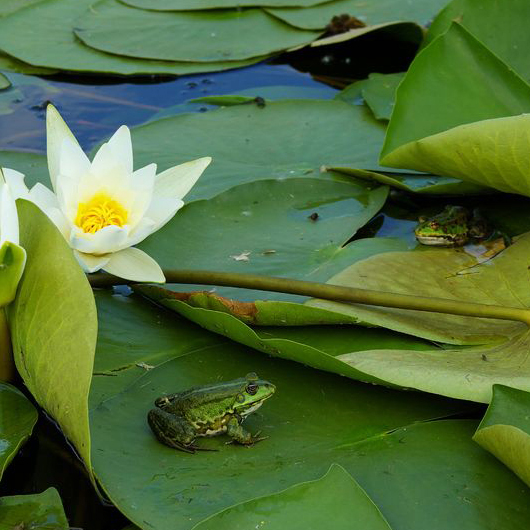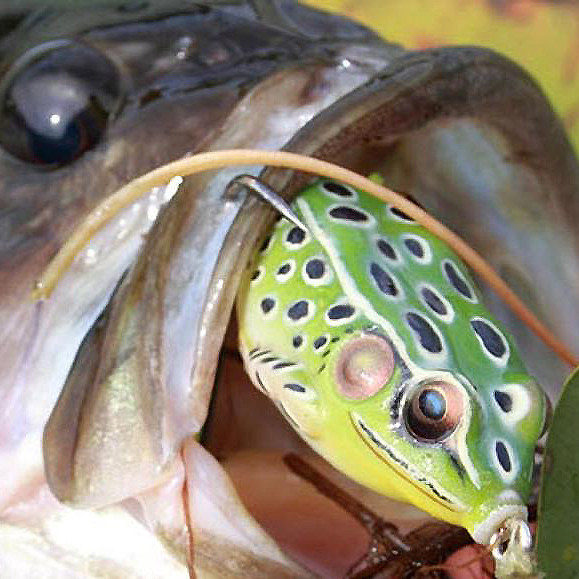Frogs For Summer Bass
When the Summer Bass are Under the Lily Pads…Try a Frog!
by Tom Vassallo
As the “lazy” days of summer approach and the temperatures drive people to the beach or into the air conditioning, it gets pretty uncomfortable for largemouth bass. After the spawn and nesting, largemouths will usually move deeper into larger bodies of water where they can effectively use Mother Nature’s air conditioning and hang in the depths where the cool water temps lay. However, in most of the waters I fish in Central and Southern New Jersey, bass will not find those deep holes in which to cool off as many of the shallow ponds and lakes heat up and there remains a few areas where the bass find cooler water.
The two main areas these fish will be found is in areas where cooler creeks and rivers feed into the lake and one other area where there is little current in smaller ponds…”down under”…that is under the many groups of lily pads that will cover the water surface for most of the “dog days” of summer.
Now I have friends that still swear that the way to fish those pads is to hit the open spaces between the pads with spinnerbaits. I am a major supporter of the spinnerbait as a spring lure, but you will usually find its effectiveness falls as the fish leave the aggressive period of pre-spawn and nesting. I try to think of the hot days of summer as a time that the fish become a bit lazier and in shallow lakes, will spend a lot of the sunny days in the cool shade of the lily pads. That means summertime is the time to change your technique…use frogs for summer bass.
I won’t lie to you, fishing a frog for summer bass is a challenge for many fisherman. Not the technique (since it is quite simple)…but the slow pace of the fishing! Many bass anglers would much rather pitch a crank bait into the cooler depths since it is fast action, but for us that don’t have that deep water, there aren’t many other choices except to use a frog for summer bass if you only have a hot and sunny Saturday or Sunday to get out on the lake.
One thing that any angler will tell you is that when a bass or pickerel explodes on a weedless frog, mouse or minnow…it is a thrill and challenge to hook and land that fish. If an angler has never experienced landing a bucketmouth this way, you owe it to yourself to give it a try. Dig down in your tackle box and use a frog for summer bass.
Any pond that has lily pads will usually allow access from shore. However, I prefer to use a small john boat to get out along the edges of the pads and pitch the frog in. Why is that important? How many frogs swim into the pads from the deep water? Frogs will almost always hang in the shallow water on the very edges of the shore and will usually venture just a short distance to sit in the pads and enjoy a fly or skeeter when they buzz by. A john boat allows a quiet drift along the pads and also a method to retrieve those errant casts into the branches. If you must fish from shore, try to cast parallel to shore and retrieve slowly along the pads close to shore. From the boat I have found the same technique from shore sometimes works very well across small open waters through the pads that lead to the deeper waters of the lake.
Many question just how to fish frogs. You need a stiff, medium heavy rod with a baitcasting or spinning rod capable of holding 12-15 pound line. You can try using braid on a lighter pole, but you will quickly discover that when a larger bass takes the lure, it will inevitably dive into the thickest part of the pads and you will need the backbone of the heavier pole and reel to “horse” that bass through the mess.
You can usually tell a pickerel from a bass in the pads. 99 times out of 100, you will see the pickerel attack from a longer distance. There will be a quick, telltale “v” across the surface and a pause. When you see that happen, just twitch that frog a touch and the pickerel should hit it. I have found that most species of fish will not hold a fake frog past the count of three. So if you can (sometimes the pads screw you up!), count a quick 1-2-3 and set the hook. I can usually tell if the predator is a bass, because 9 times out of 10, they will hit the frog immediately as it passes over them. I also like to aim just past the edge of a small hole in the pads and wait for the water to settle. Then I twitch and slowly swim the frog into the open hole and pause. Always keep a tight line! The bass will not usually explode on the bait, but will move below it and inhale it very quickly. That is when you really need a quicker 1-2-3 and set that hook. When and if that hook is set, the bass will dive and jump and do everything it can to throw that lure. You MUST keep that tight line! That is when I lose most of my fish, is after the hook set. That is the big challenge of fishing a frog in the thick stuff.
If you do have access to a deeper water pond, many think they are unfishable when covered in that thick, green slime. Not true! I had my best day of frog fishing a slime covered pond in the mountains of Northeast Pennsylvania. My “go to” frog of late is a Booyah Pad Crasher in “bullfrog” colors. However, this frog seems to be a bit large in the water I fish. Booyah’s smallest body size is a two-inch body. The Koppers Live Target Hollow Body Frog is nearly identical to the Booyah, but offers a smaller 1 ¾ inch body. I will be trying one of those soon. But the oldest frogs in my tacklebox and the ones I have landed the most fish on is the old SnagProof frog in green and brown. It doesn’t look fancy, but it does the trick. I think the overall size of it is not intimidating to the fish as some of the larger frogs are.
If you haven’t put away the spinnerbait yet, the “dog days” of summer are upon us and that is prime weedless frog time. Slap on the sunscreen, grab the john boat and your polarized glasses and get out the pond. When that chunky bass explodes on your topwater frog, you’ll be glad you did. Now get out there and fish!




Leave a comment